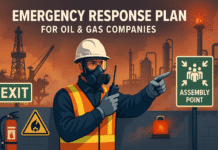
Introduction
Fire hazards pose a significant threat to workplaces, potentially leading to devastating consequences. Implementing effective control measures is crucial to ensuring the safety and well-being of employees and preventing costly damages. This article discusses the various fire hazards commonly found in workplaces and explores the essential control measures that employers should adopt to mitigate the risks and promote a secure working environment.
Fire Hazards & Control Measures at Workplace
Fires can occur in any workplace, regardless of its size or industry. Understanding the potential fire hazards is the first step in preventing fire accidents. Fire hazards refer to conditions or practices that increase the likelihood of fire occurrence. Common causes of workplace fires include electrical malfunctions, improper handling of flammable materials, and human errors. When fire strikes, it can result in severe injuries, loss of life, property damage, and business interruption.
Fire Safety Regulations and Standards
To address fire hazards effectively, employers must adhere to specific fire safety regulations and standards. These regulations are set forth by local authorities and industry-specific organizations to ensure that businesses implement necessary safety measures. Compliance with these standards not only reduces the risk of fire incidents but also helps businesses avoid legal liabilities and penalties.
Identifying Fire Hazards in the Workplace
Conducting a thorough fire hazard assessment is essential in identifying potential risks. Employers should be vigilant in recognizing ignition sources such as faulty wiring, heating equipment, and open flames. Additionally, understanding the presence of flammable materials and their safe storage is crucial to preventing fires.
Preventive Measures for Fire Safety
Preventive measures play a pivotal role in mitigating fire hazards. Proper housekeeping practices, such as maintaining clutter-free workspaces, reduce the risk of fires. Regular electrical safety checks and safe handling of flammable substances are equally important in fire prevention. Providing comprehensive fire safety training to employees ensures that they are well-equipped to respond appropriately in case of an emergency.
Fire Safety Equipment
Equipping the workplace with the right fire safety equipment is a crucial aspect of fire hazard control. Fire extinguishers are essential tools for tackling small fires, while fire sprinkler systems and smoke detectors offer passive protection. Adequate maintenance of this equipment is vital to ensure their functionality when needed.
Emergency Evacuation Procedures
Having a well-designed emergency evacuation plan in place is critical to ensuring the safe evacuation of all personnel in the event of a fire. Regular fire drills help employees become familiar with evacuation routes and procedures, enhancing their preparedness in real emergencies.
Fire Safety Responsibilities
Fire safety is a collective responsibility that involves every individual in the workplace. Employees must be aware of their roles in fire safety, while designated fire wardens have specific duties to fulfill during fire incidents.
Maintaining Fire Safety
Regular inspections and updating safety protocols are vital to maintaining a high level of fire safety in the workplace. Identifying and addressing potential hazards promptly can prevent accidents from occurring.
Dealing with Fire Incidents
In the unfortunate event of a fire, immediate action is crucial. Employees should know how to respond swiftly and calmly. Contacting emergency services promptly is essential for timely assistance.
Fire Hazards in Specific Work Environments
Different workplaces may have specific fire hazards that require unique control measures. For instance, offices may face electrical fire risks, while industries dealing with hazardous materials have their challenges. Understanding and addressing these specific risks are vital for comprehensive fire safety.
Promoting Fire Safety Culture
Building a strong fire safety culture within the organization involves instilling awareness and responsibility among employees. Encouraging active participation and engagement in fire safety initiatives fosters a safer working environment.
The Importance of Fire Safety Training
Regular fire safety training sessions are instrumental in preparing employees for potential fire incidents. Simulating real-life fire scenarios during training helps individuals respond effectively under pressure.
Incorporating Technology for Fire Safety
Advancements in technology have led to the development of fire-resistant building materials and advanced fire suppression systems. Employing such innovations enhances the overall fire safety of the workplace.
Conclusion
Fire hazards at the workplace are serious threats that demand proactive measures. Employers must prioritize fire safety by implementing preventive measures, providing proper training, and adhering to relevant regulations. By cultivating a fire-safe culture and staying vigilant, businesses can safeguard their employees and assets from the devastating effects of fires.
FAQs
- What are fire hazards in the workplace? Fire hazards refer to conditions or practices that increase the likelihood of fire occurrence at the workplace. They can include electrical faults, flammable materials, and improper storage of hazardous substances.
- Why is fire safety training essential? Fire safety training equips employees with the knowledge and skills to respond effectively during fire emergencies, reducing panic and potential injuries.
- What is the role of fire wardens? Fire wardens have specific duties during fire incidents, including guiding employees to safety, operating fire safety equipment, and assisting emergency services.
- How can businesses comply with fire safety regulations? Businesses can comply with fire safety regulations by conducting regular fire risk assessments, implementing necessary safety measures, providing fire safety training to employees, and ensuring the proper maintenance of fire safety equipment.
- What are some common fire safety mistakes to avoid? Some common fire safety mistakes to avoid include blocking emergency exits, overloading electrical outlets, neglecting to test smoke detectors, and storing flammable materials in unsafe areas.
- How often should fire drills be conducted? Fire drills should be conducted at least twice a year to ensure that employees are familiar with evacuation procedures and can respond efficiently during an actual fire emergency.
- What should employees do in case of a fire? In case of a fire, employees should immediately activate the fire alarm, evacuate the building using designated escape routes, and assemble at the designated assembly point outside the building.
- How can businesses prevent electrical fires? To prevent electrical fires, businesses should regularly inspect and maintain electrical equipment, avoid overloading circuits, and replace damaged or frayed electrical cords promptly.
























